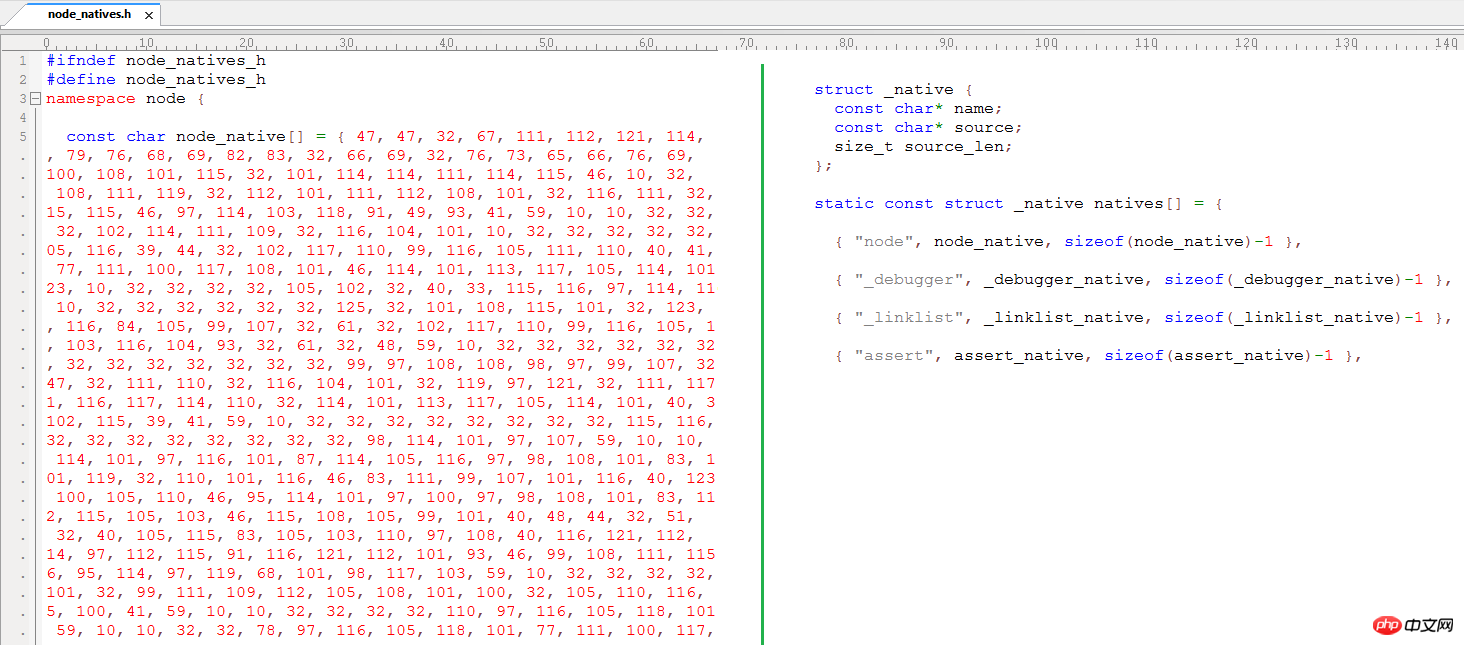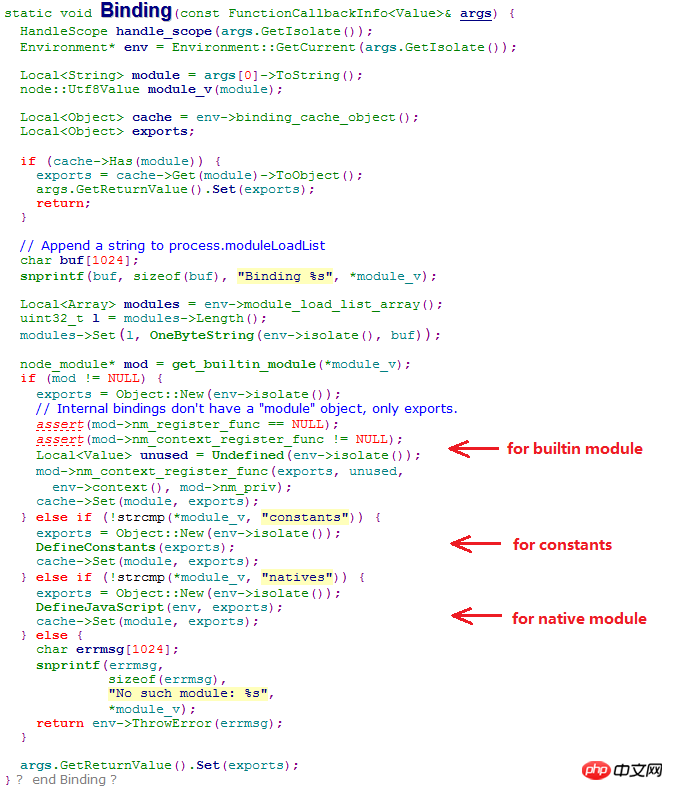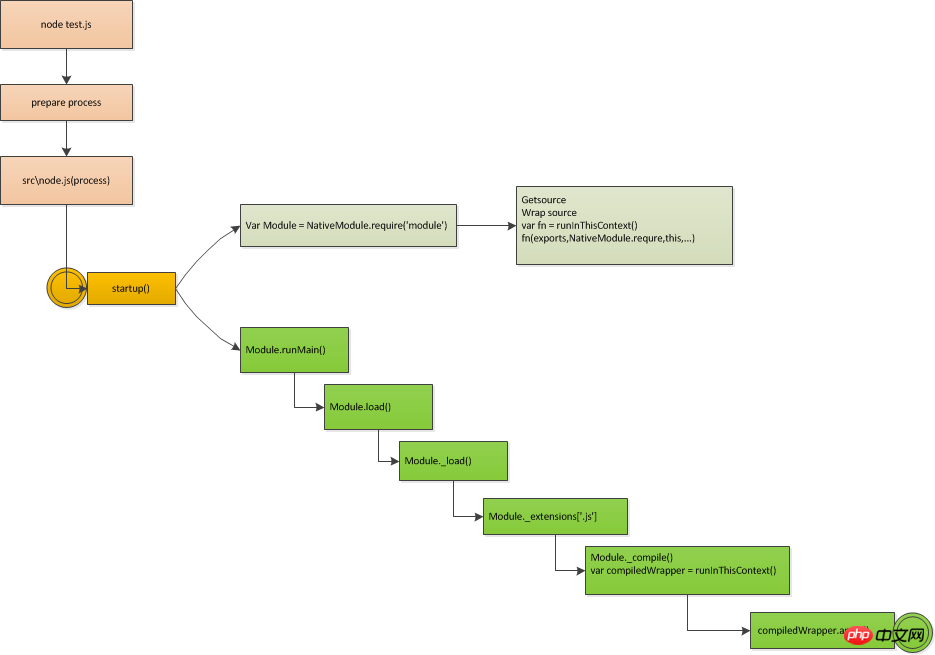 Web Front-end
Web Front-end
 JS Tutorial
JS Tutorial
 Detailed explanation of Nodejs module loading and operation principle
Detailed explanation of Nodejs module loading and operation principle
Detailed explanation of Nodejs module loading and operation principle
When using Nodejs, it is inevitable to refer to third-party modules. Some of them are built-in with Nodejs (for example: http, net...), and some are published on npm (for example: mssql, elasticsearch...)
This chapter focuses on 3 issues:
The loading process of Nodejs module.
The process of application startup.
How the application loads dependent modules.
1. Module loading process
Nodejs modules can be roughly divided into 4 types:
a) builtin module Nodejs module provided in C++.
b) constant module A module that defines constants in Nodejs.
c) native module Module provided in javascript form in Nodejs.
d) Third-party module Modules provided by third parties.
Let’s first look at the generation process of builtin module and native module.

The generation of native JS module is relatively complicated. After compilation, a node_natives.h will be generated in the /out/release/obj/gen directory.
This file is generated by js2c.py. It will convert all js files in the lib directory in the Nodejs source code into ASCII codes and store them in the corresponding array.

builtin C++ module generation process is relatively simple. Each builtin C++ module entry will be expanded into a func through the macro NODE_MODULE_CONTEXT_AWARE_BUILTIN. For example, for the tcp_wrap module, it will be expanded into static void register_tcp_wrap() attribute(constructor) function.
Friends who are familiar with GCC know that the function modified by attribute (constructor) will be executed before the main() function of Nodejs. In other words, the builtin C++ module will be loaded before the main() function. modlist_builtin list, and modlist_builtin is a pointer of type struct node_module, get_builtin_module() will traverse to find the module we need.
In fact, whether it is a naive JS module or a builtin C++ module, it will eventually be compiled into an executable file. The extraction methods of the two are quite different. The js module uses process.binding('natives'), while the C++ module uses get_builtin_module() directly.
A binding() function is provided in node.cc. When we use require() to reference another module, the binding() function will be introduced. Let's analyze this function:

It can be seen visually that the function mainly serves three modules: builtin, constants and native.
builtin has the highest priority and will be searched in modlist_builtin. The process is very simple. Just traverse the entire list and search for modules with the same name. After being found, the module's registration function will be executed first, and then the data exports will be returned.
The constants module has the second priority, and the constant definitions in Nodejs are exported through constants.
native has the lowest priority.
2. Application startup process

The above picture is a flow chart, which describes the startup of test.js as a parameter Begin and eventually be executed. The whole process can be divided into 4 steps:
1. Executable file node: node entry, which mainly plays the role of environment preparation during the startup process
2.src/node.js: startup script
3.Native Module: Prepare for the execution of module.js
4.module.js: native module, used to load, compile, and execute applications
How the application loads dependent modules
As mentioned earlier, NativeModule.require() is only responsible for helping to reference natives modules, which is enough for lib/module.js.
But it is obvious that general applications need to reference not only the matatives module, but also third-party modules. Let us take a look at the Module.prototype._require() function in module.js.

Related recommendations:
In-depth understanding of NodeJS
nodeJS implements WeChat function sharing
The above is the detailed content of Detailed explanation of Nodejs module loading and operation principle. For more information, please follow other related articles on the PHP Chinese website!

Hot AI Tools

Undresser.AI Undress
AI-powered app for creating realistic nude photos

AI Clothes Remover
Online AI tool for removing clothes from photos.

Undress AI Tool
Undress images for free

Clothoff.io
AI clothes remover

AI Hentai Generator
Generate AI Hentai for free.

Hot Article

Hot Tools

Notepad++7.3.1
Easy-to-use and free code editor

SublimeText3 Chinese version
Chinese version, very easy to use

Zend Studio 13.0.1
Powerful PHP integrated development environment

Dreamweaver CS6
Visual web development tools

SublimeText3 Mac version
God-level code editing software (SublimeText3)

Hot Topics
 1359
1359
 52
52
 The difference between nodejs and tomcat
Apr 21, 2024 am 04:16 AM
The difference between nodejs and tomcat
Apr 21, 2024 am 04:16 AM
The main differences between Node.js and Tomcat are: Runtime: Node.js is based on JavaScript runtime, while Tomcat is a Java Servlet container. I/O model: Node.js uses an asynchronous non-blocking model, while Tomcat is synchronous blocking. Concurrency handling: Node.js handles concurrency through an event loop, while Tomcat uses a thread pool. Application scenarios: Node.js is suitable for real-time, data-intensive and high-concurrency applications, and Tomcat is suitable for traditional Java web applications.
 The difference between nodejs and vuejs
Apr 21, 2024 am 04:17 AM
The difference between nodejs and vuejs
Apr 21, 2024 am 04:17 AM
Node.js is a server-side JavaScript runtime, while Vue.js is a client-side JavaScript framework for creating interactive user interfaces. Node.js is used for server-side development, such as back-end service API development and data processing, while Vue.js is used for client-side development, such as single-page applications and responsive user interfaces.
 Is nodejs a backend framework?
Apr 21, 2024 am 05:09 AM
Is nodejs a backend framework?
Apr 21, 2024 am 05:09 AM
Node.js can be used as a backend framework as it offers features such as high performance, scalability, cross-platform support, rich ecosystem, and ease of development.
 How to connect nodejs to mysql database
Apr 21, 2024 am 06:13 AM
How to connect nodejs to mysql database
Apr 21, 2024 am 06:13 AM
To connect to a MySQL database, you need to follow these steps: Install the mysql2 driver. Use mysql2.createConnection() to create a connection object that contains the host address, port, username, password, and database name. Use connection.query() to perform queries. Finally use connection.end() to end the connection.
 What is the difference between npm and npm.cmd files in the nodejs installation directory?
Apr 21, 2024 am 05:18 AM
What is the difference between npm and npm.cmd files in the nodejs installation directory?
Apr 21, 2024 am 05:18 AM
There are two npm-related files in the Node.js installation directory: npm and npm.cmd. The differences are as follows: different extensions: npm is an executable file, and npm.cmd is a command window shortcut. Windows users: npm.cmd can be used from the command prompt, npm can only be run from the command line. Compatibility: npm.cmd is specific to Windows systems, npm is available cross-platform. Usage recommendations: Windows users use npm.cmd, other operating systems use npm.
 Is nodejs a back-end development language?
Apr 21, 2024 am 05:09 AM
Is nodejs a back-end development language?
Apr 21, 2024 am 05:09 AM
Yes, Node.js is a backend development language. It is used for back-end development, including handling server-side business logic, managing database connections, and providing APIs.
 What are the global variables in nodejs
Apr 21, 2024 am 04:54 AM
What are the global variables in nodejs
Apr 21, 2024 am 04:54 AM
The following global variables exist in Node.js: Global object: global Core module: process, console, require Runtime environment variables: __dirname, __filename, __line, __column Constants: undefined, null, NaN, Infinity, -Infinity
 Is there a big difference between nodejs and java?
Apr 21, 2024 am 06:12 AM
Is there a big difference between nodejs and java?
Apr 21, 2024 am 06:12 AM
The main differences between Node.js and Java are design and features: Event-driven vs. thread-driven: Node.js is event-driven and Java is thread-driven. Single-threaded vs. multi-threaded: Node.js uses a single-threaded event loop, and Java uses a multi-threaded architecture. Runtime environment: Node.js runs on the V8 JavaScript engine, while Java runs on the JVM. Syntax: Node.js uses JavaScript syntax, while Java uses Java syntax. Purpose: Node.js is suitable for I/O-intensive tasks, while Java is suitable for large enterprise applications.



